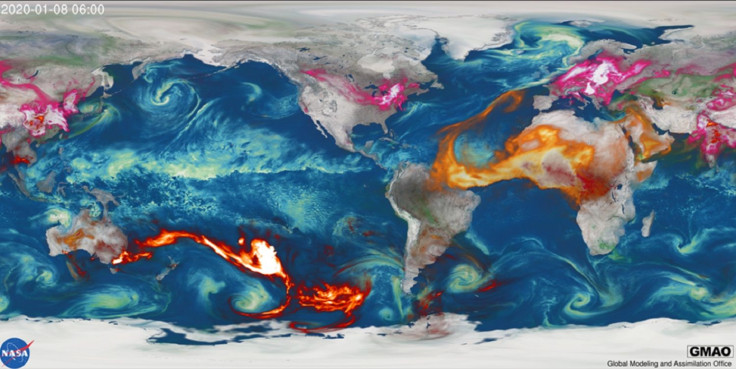NASA Animation Shows Global Transport Of Smoke From Australian Fires
KEY POINTS
- A NASA animation shows the global distribution of aerosols starting from August 2019
- Smoke from the Australian bushfires can be seen bursting forth from the region
- The smoke has interacted with global weather, leading to its global transport
The Australian fires have devastating effects on local life and property, but the entire region is actually affected by the smoke. A video released by NASA shows global aerosols, including smoke from the Australian bushfires, being transported across the globe.
Global Smoke Transport
NASA released a video that shows the transport of different aerosols and how they are interacting with global weather. In the clip, the aerosols are highlighted by color, with dust in orange, sea salt in blue, nitrates in pink, and carbonaceous aerosols in red. The brighter colors represent higher aerosol amounts.
In the video, which shows the global aerosol distribution from August 2019 until January 2020, we can also see several high impact events that occurred during the time frame such as Hurricane Dorian, the fires in Indonesia and South America, and the extreme wildfires in Australia.
For the first half of the clip, only small bursts of red smoke appear from Australia until around November when bright red plumes burst from the location of the country. From there, the smoke can be seen traveling across the ocean and interacting with global weather.
“As smoke from the massive fires has interacted with global weather, the transport of smoke plumes around the globe has accelerated into the upper troposphere and even the lowermost stratosphere, leading to long-range transport around the globe,” NASA explained.
As such, the smoke from the bushfires will complete a circle around the Earth and back to Australia again.
Also seen in the video are the dust from desert regions, the sea salt emitted over the oceans, and several forms of pollution emitted from industrial activities.
Wildfires
Wildfires are, actually, quite normal and may even be beneficial to an ecosystem because the fires can kill diseases and pests, and even allow for new grasslands to be created. However, human activities have since resulted in bigger and more destructive ones. Such fires can emit significant amounts of carbon dioxide in a very short time. In fact, scientists estimated that wildfires have emitted billions of tons of carbon dioxide per year for the last 20 years.
Unfortunately, wildfires have also been worsening in some parts of the world, particularly in the regions that are drying out because of global warming. Even after big fires, the decomposing wood also emits carbon dioxide, sometimes even surpassing the emissions from the actual fire.
Numerous wildfires are actually started due to human carelessness, from leaving unextinguished campfires to throwing cigarette butts. By taking simple preventative measures such as being more aware of how we discard flammable items, we can lower the threats associated with the devastating events.

© Copyright IBTimes 2025. All rights reserved.






















